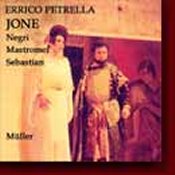The last confirmed performance in Italy took place in Palermo
in 1924. After that, nothing anywhere in the world, except for the revival in
Caracas in 1981, that was recorded and issued. First on an Italian LP, and
now on a CD released in Argentina.
There is a bit of a mystery here. How could a composer have been so
successful and popular about 100 years ago, with at least three operas
(Jone, La Contessa d’Amalfi and Le
precauzioni) in the standard repertory, and be so completely forgotten
and neglected today? Unlike the works of Pacini and Mercadante, and several
other composers of the period, those of Petrella have not experienced any
return to popularity. In fact, the last Petrella opera to be given in Italy
was I Promessi Sposi, in Naples, back in 1950, over 55 years ago. I
don’t have an answer to that, except perhaps that there may have been a
greater interest in reviving the works of composers who influenced Verdi,
like Pacini and Mercadante, than those who, like Petrella, were influenced by
him. Another factor may well have been that Petrella had earned Verdi’s
scorn.
Petrella had been born in Palermo on December 10, 1813, the same year as
both Verdi and Wagner. But while he did lack the greatness of the other two,
especially Verdi, much of his music, certainly including Jone, makes
for pleasant listening. He was a very popular composer in his day, both of
comic and tragic operas. None of his early works, premiered between December
1829 and 1839 were particularly successful. It was not until Il carnevale
di Venezia (Naples, Teatro Nuovo, May 20, 1851) that he really became
noticed. Elena di Tolosa (Naples, Fondo, Aug. 12, 1852) followed.
Then, in 1854, he took the Italian operatic world by storm with Marco
Visconti (Naples, San Carlo, 1854). L'assedio di Leida (La
Scala, 1856) was his fourth straight triumph, while Jone (La Scala,
1858) was a major event and remained in the repertory well into the 20th
century. The creators were Augusta Albertini in the title role, the prominent
spinto tenor Carlo Negrini, who also was the original Gabriele in Simon
Boccanegra as Glauco, and Giovanni Guicciardi, the first De Luna as the
wicked Arbace.With two exceptions (La Contessa d'Amalfi and I
Promessi Sposi) his operas during the 1860s generally failed.
I was already very familiar with Simon Boccanegra, when I first
heard Jone, the two operas having their premieres within less than a
year of each other, and found it hard to understand how the Petrella work,
which may have had as many as 600 productions, could have been so much more
successful than the Verdi, which was produced about 60 times (counting both
versions) during the 19th century. To give a better idea of the popularity of
Jone, it was given all over Italy and Spain, and as far away as
Melbourne, Alexandria, Calcutta, Jakarta, Santiago, Lima, Manila and Tbilisi.
But it was never staged in Paris, Berlin or Moscow, and only once each in
London (by amateurs) and Vienna (by an Italian company returning from a
season in Bucharest). Its one time popularity was almost certainly due to
such striking pieces as two fine numbers for the tenor (a drinking song and a
romanza), the baritone’s great aria and cabaletta in Act III, and one
of the most effective funeral marches in all of opera.
Much as I have enjoyed this performance of Jone in its several
incarnations, I am convinced that a better cast than the one provided here
could have made a much better case for the opera. Of the three principals,
only baritone Gian Piero Mastromei really acquits himself with full honors.
He is a fine “Verdi baritone”, and has proved himself time and
again in many leading roles all over the world’s stages and on CD.
Negri also had a fine career, including several season at the Metropolitan
Opera. But, until another Verdi baritone of Mastromei's stature is found, and
a tenor of the same caliber utilized for Glauco, this will be the only game
in town.
The presentation of the opera is basically of the “bare bones”
type. There is no libretto, no liner notes, and only a plot of the opera in
Spanish, but without translation, not even into Italian or English. It is
apparently intended for the Argentine market, not surprising since it is part
of a series of CDs featuring the soprano Adelaide Negri, herself
Argentinian.. A look at Adelaide Negri’s web site (www.adelaidanegri.com) tells us that
they are dedicated to issuing Ms. Negri’s performances of a vast
repertory, much of which originates in Buenos Aires. Others in the series
include many Donizetti, Rossini, and Verdi operas. Most have been recorded many times,
but other relative rarities include Spontini’s Fernando
Cortez, Pacini’s Saffo and Meyerbeer’s
L’africana.
If you are looking for a masterpiece sung by an all-star cast, this
recording is not for you. On the other hand, if you cannot resist important
19th century works that once had a great appeal to the audiences for whom
they were composed, you should get quite a bit of enjoyment from it.
Tom Kaufman
